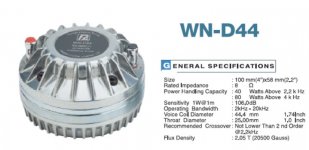JBL 2446H/JCompression Driver
100 watts continuous program at 500 Hz
150 watts continuous program at 1 kHz and higher
Nominal Efficiency: 30% (500 Hz to 2.5 kHz)
Frequency Range: 500 Hz to 20 kHz
Recommended Crossover: 500 Hz or higher, 12 dB/octave minimum
What will be the power watts of compression driver if cutoff is 2 khz or higher?
Last edited:
There are 2 limits on any driver. Thermal and excursion.hat will be the power watts of compression driver if cutoff is 2 kHz or higher?
Put too much power into a driver and it melts.
Put too much power at a low frequency into a driver, and the motor throws the cone on the floor.
Interpreting the spec, below 1K, the driver is excursion limited. Above, its thermal limited. In other words, 150 W at 1K or Higher.
HTH
Doug
I am Sorry to repeat.
I don't want to use jbl driver.
I just want to know calculation of how the power watts changes with frequency.
Here is another driver example.
This is Paudio WN D44. Here also they hv given different power watts at different frequency.
I don't want to use jbl driver.
I just want to know calculation of how the power watts changes with frequency.
Here is another driver example.
This is Paudio WN D44. Here also they hv given different power watts at different frequency.
Attachments
This is "Continuous program" rating. From JBL spec sheets:
This is a pink noise measurement, with power decreasing with frequency:
http://en.wikipedia.org/wiki/Pink_noise
Continuous program is defined as 3 dB greater than continuous pink noise and is a conservative expresssion of the transducer’s ability to handle normal speech and music program material. Continuous pink noise power ratings are rested with pink noise input having a 6 dB crest factor, with a high-pass filter set at the specified lower limiting frequency for two hours duration
This is a pink noise measurement, with power decreasing with frequency:
http://en.wikipedia.org/wiki/Pink_noise
I am Sorry to repeat.
I don't want to use jbl driver.
I just want to know calculation of how the power watts changes with frequency.
It doesnt change *because of* frequency...
Instead it is a lot of limiting factors that can destroy a driver, and at different frequencies then different factors will be the factor that sets the limit.
For instance: At lower frequencies it will usually be damaged by overexcurssion, but at higher frequencies where excursion is lower then the heat dissipation will be the limiting factor.
However, it is a lot more complicated than that...
The JBL driver mentioned earlier is usually crossed over at about 1.4KHz and driven with over 1000watt, and it will hold for decades with that amplifier.
Why? because music is usually very short bursts of power that doesnt heat the motor enough to burn it, but also with a lot of time inbetween bursts to allow the heat to travel out of the driver...
-It is not the power that destorys the driver, it is the temperature...
An another thing to consider is that impedance changes with frequency, so you need different amplifiers to put the same amount of power thru the driver at different frequencies.
So, the only reliable way to see what power it will handle is to make a model of every single detail in the driver *and horn* and then calculate all the limiting factors to see which one that will break first for each frequency.
- Status
- This old topic is closed. If you want to reopen this topic, contact a moderator using the "Report Post" button.
- Home
- Loudspeakers
- Multi-Way
- Compression driver watts?
